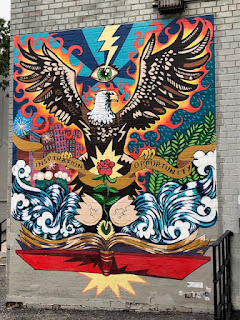Perhaps it's because I've lived in New York most of my life: For me, bicycling and public art have become more and more intertwined.
These days, however, one doesn't have to go to biketopias like Portland or Amsterdam or art havens like Paris or New York to experience murals, large sculptures or installations during a ride. It seems that smaller 'burgs are getting in on the idea of combining the two. I think it has to do with increasing numbers of artists living and working outside of the traditional creative capitals for any number of reasons (not the least of which is the cost of studio space, supplies, or simply feeding and housing one's self) and cycling becoming a transportation option and recreation choice for many more people.
Among the communities that are bringing cycling and art together are the city of Kalamazoo and its eponymous Michigan county. To that end, Bike Friendly Kalamazoo commissioned a mural that is going up along Lovers Lane, a popular cycling route in the city of Portage.
 |
| Photo by Dan Nichols for WWMT |
The very colorful 17-by-58 foot image is being painted by local artists and is slated to be finished by the 15th of this month. On that day, a public engagement will be held for the families that helped to paint it.
For the creator of the mural, Ellen VanderMyde, working on this project combines her passions for pedaling and painting. She grew up in Portage and "grew up cycling this path" and hopes that people will ride to the mural to see it in person.
"We wanted to express the joys of cycling," explained Bicycle Friendly Kalamazoo President Paul Selden. He hopes that "everybody who sees it would maybe want to get on a bicycle and if not maybe give those who are on bicycles a little more space on the road."
He also hopes to have another mural completed this year and that it, along with the work in progress, will be the beginning of more such installations.
As far as I am concerned, public works of art readily visible to cyclists--whether or not those works are bicycle-themed--are part of a city's cycling infrastructure. If nothing else, I'd rather see a mural or a sculpture while I'm riding than risk my bike or my self on a poorly-conceived, -built or -maintained bike lane.


























.jpg)